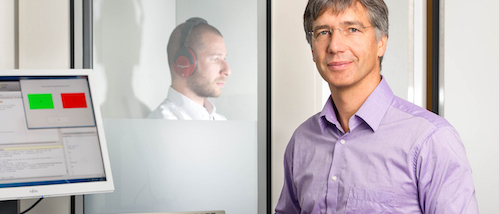A team of researchers led by MSB-PI Werner Hemmert have applied the latest computer modelling techniques to create better cochlear implants (CIs).
CIs are surgically implanted devices that provide a sense of sound to a person with moderate to profound sensorineural hearing loss. The cochlea itself is the part of the inner ear involved in hearing, comprising a spiralled, hollow, conical chamber of bone with a thin, delicate lining of epithelial tissue.
CIs bypass the sensory hair cells and directly excite the remaining fibres of the auditory nerve with electrical currents to provide the sensation of hearing. Although they are a proven method for restoring hearing, CIs are limited by a broad current spread inside the fluid filled inner ear. The broad current spread limits the number of effective electrodes and leads to poor spectral resolution.
The CIModelPLUS project addressed this challenge by providing an advanced model of the cochlea for engineers, which facilitates the development of next-generation CIs by revealing greater accuracy of the electric current distribution in the tissues and the electrical excitation of single nerve fibres. The research was undertaken with the support of the Marie Skłodowska-Curie programme.
Improved detail
In current cochlear models, many detailed features of the cochlea anatomy have not been included. For example, the microstructures inside the bony axis known as the modiolus, where spiral ganglion neurons reside and neural fibres as well as blood vessels run through. "Most models of the inner ear were constructed using uniform and smooth geometries. These models predict uniform and smooth excitation patterns of the auditory nerve fibres," says Prof. Werner Hemmert, who hosted the project at the Technical University of Munich.
Researchers therefore carried out high-resolution structural scans using X-ray microtomography to identify the cochlea and reconstruct a precise 3D model from the images. The reconstruction process involved segmenting each tissue individually slice-by-slice, requiring detailed knowledge of anatomy and physiology to ensure the accuracy of the model structure and tissue property.
The finite element (FE) method was then used to numerically approximate the electric current distribution in the 3D cochlear model as a result of electrical stimulation from CI electrodes. Scientists then developed an advanced computational model of the cochlea by combining the simulation and experimental results.
Major benefits
Based on the high-resolution 3D model the project team also reconstructed the path of ANFs inside the cochlea model. This reconstruction was performed using an in-house developed semi-automated algorithm to search for the path of the neurons through the spongy modiolar bone. "When we now use our model, the excitation patterns of the auditory nerve look much more complicated because they are sensitive to small anatomical variations" explains Dr Siwei Bai, the postdoctoral researcher who was awarded with the Marie Skłodowska-Curie fellowship.
To validate their 3D model simulation, researchers in the group used CI recipients as test subjects. "Using already-implanted CI electrodes, we directly measured the electric potential within their cochleae. The voltage spread predicted by the model was lying very well in the measured range, indicating that the precision of the model parameters is already quite good," Dr Bai observes.
Prof. Hemmert points out: "We are now able to simulate electrophysiological observations by combining our FE model and an appropriate biophysical multi-compartment cable model applied on these reconstructed ANFs." CIModelPLUS will thus help understanding how CIs excite the auditory nerve and provide the basis for better neuro-implants and improved CIs in particular, thereby improving the quality of life of people suffering from hearing loss.
© European Union, 2019
Source: CORDIS, https://cordis.europa.eu/project/rcn/202762/brief/en
Scientific Contact:
Prof. Dr.-Ing. Werner Hemmert
Professor of Bio-inspired Information Processing
Phone: +49 89 289 10853
email:werner.hemmert@tum.de
Web: http://www.bai.ei.tum.de
Media Relations MSB:
Dr. Paul Piwnicki
Phone: +49 89 289 10808
Email: paul.piwnicki@tum.de
